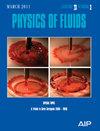Nonlinear three-dimensional modeling for encapsulated microbubble dynamics subject to ultrasound
IF 4.3
2区 工程技术
Q1 MECHANICS
引用次数: 0
Abstract
Encapsulated microbubbles (EMBs) stabilized by thin coatings have been used as contrast agents for ultrasound sonography as well as having been demonstrated as a promising new technology for targeted drug delivery. The dynamics of EMBs is three-dimensional (3D) because EMBs within micro-vessels inevitably interact with boundaries, but the theoretical and numerical studies are limited to spherical, weakly non-spherical, and/or axisymmetric EMBs. Here, we have developed physical, mathematical, and numerical models for nonlinear 3D EMB dynamics. The liquid flow is evaluated using the boundary integral method. The EMB coating is modeled as a thin viscoelastic shell including stretching, bending, and shear effects and simulated using the finite element method. These models are coupled through the kinematic and dynamic boundary conditions at the interface. The model is in good agreement with the Hoff equation for spherical EMBs and the asymptotic theory for weakly non-spherical deformation of EMBs. Using this model, a numerical study for EMB dynamics near a rigid boundary subject to an ultrasonic wave is performed. The migration, non-spherical oscillation, resonant oscillation, and jetting of EMBs are displayed and analyzed systematically. If the ultrasound wave is strong, a high-speed liquid jet forms at the final stage of the collapse, orientated between the directions of the wave and toward the wall. The EMB jet is weaker and slower and has less momentum, as the non-spherical deformation of the coating and the jetting are suppressed by the viscoelastic property of the coating. If the ultrasound is not strong, the EMB remains spherical for many cycles of oscillation but the EMB undergoes resonant oscillation and becomes significantly non-spherical after several oscillation cycles, when the wave frequency is equal to its natural frequency. The numerical capability has the potential to be developed for the optimization of sonography or drug delivery.受超声波影响的封装微泡动力学非线性三维建模
由薄涂层稳定的封装微气泡(EMBs)已被用作超声波造影的造影剂,同时也被证明是一种前景广阔的靶向给药新技术。由于微血管内的 EMB 不可避免地会与边界相互作用,因此 EMB 的动力学是三维(3D)的,但理论和数值研究仅限于球形、弱非球形和/或轴对称 EMB。在此,我们建立了非线性三维 EMB 动力学的物理、数学和数值模型。液体流动采用边界积分法进行评估。EMB 涂层被建模为粘弹性薄壳,包括拉伸、弯曲和剪切效应,并使用有限元法进行模拟。这些模型通过界面上的运动和动态边界条件进行耦合。该模型与球形 EMB 的霍夫方程和 EMB 弱非球形变形的渐近理论十分吻合。利用该模型,对超声波作用下刚性边界附近的 EMB 动力学进行了数值研究。系统地显示和分析了 EMB 的迁移、非球形振荡、共振振荡和喷射。如果超声波很强,在塌陷的最后阶段会形成高速液体喷射,方向介于波的方向之间,并朝向壁面。由于涂层的粘弹性特性抑制了涂层的非球形变形和喷射,因此 EMB 喷射较弱,速度较慢,动量较小。如果超声波不强,EMB 在多次振荡周期中仍保持球形,但当波频等于其固有频率时,EMB 会发生共振振荡,并在几个振荡周期后明显变为非球形。这种数值计算能力可用于优化超声造影或药物输送。
本文章由计算机程序翻译,如有差异,请以英文原文为准。
求助全文
约1分钟内获得全文
求助全文
来源期刊

Physics of Fluids
物理-力学
CiteScore
6.50
自引率
41.30%
发文量
2063
审稿时长
2.6 months
期刊介绍:
Physics of Fluids (PoF) is a preeminent journal devoted to publishing original theoretical, computational, and experimental contributions to the understanding of the dynamics of gases, liquids, and complex or multiphase fluids. Topics published in PoF are diverse and reflect the most important subjects in fluid dynamics, including, but not limited to:
-Acoustics
-Aerospace and aeronautical flow
-Astrophysical flow
-Biofluid mechanics
-Cavitation and cavitating flows
-Combustion flows
-Complex fluids
-Compressible flow
-Computational fluid dynamics
-Contact lines
-Continuum mechanics
-Convection
-Cryogenic flow
-Droplets
-Electrical and magnetic effects in fluid flow
-Foam, bubble, and film mechanics
-Flow control
-Flow instability and transition
-Flow orientation and anisotropy
-Flows with other transport phenomena
-Flows with complex boundary conditions
-Flow visualization
-Fluid mechanics
-Fluid physical properties
-Fluid–structure interactions
-Free surface flows
-Geophysical flow
-Interfacial flow
-Knudsen flow
-Laminar flow
-Liquid crystals
-Mathematics of fluids
-Micro- and nanofluid mechanics
-Mixing
-Molecular theory
-Nanofluidics
-Particulate, multiphase, and granular flow
-Processing flows
-Relativistic fluid mechanics
-Rotating flows
-Shock wave phenomena
-Soft matter
-Stratified flows
-Supercritical fluids
-Superfluidity
-Thermodynamics of flow systems
-Transonic flow
-Turbulent flow
-Viscous and non-Newtonian flow
-Viscoelasticity
-Vortex dynamics
-Waves
 求助内容:
求助内容: 应助结果提醒方式:
应助结果提醒方式:


